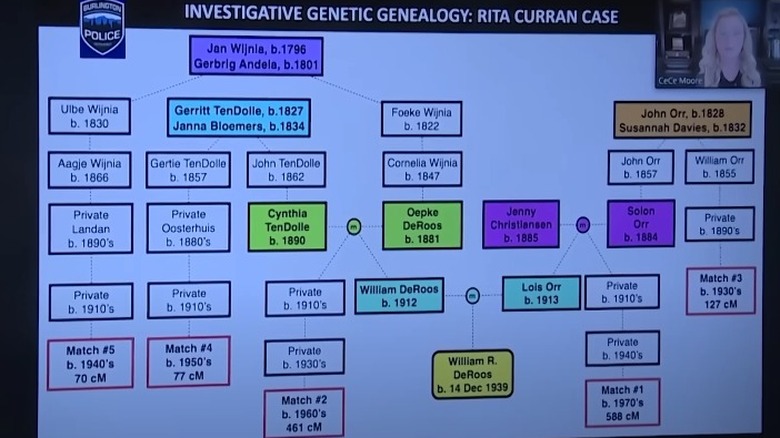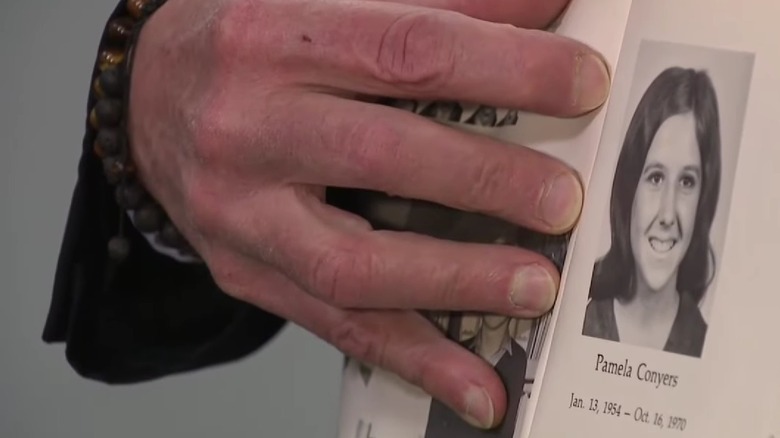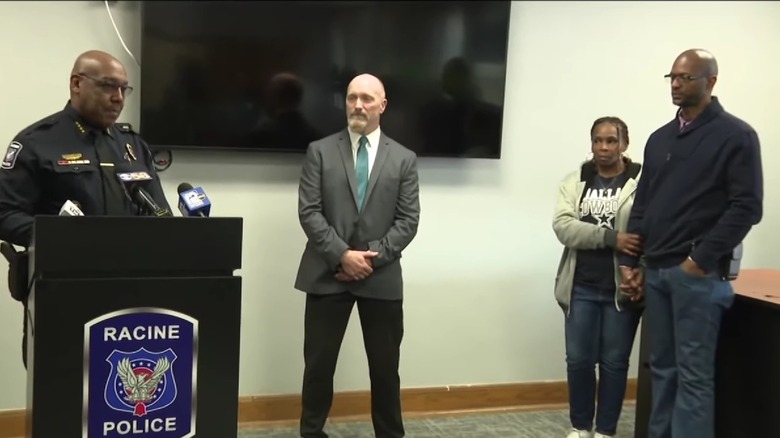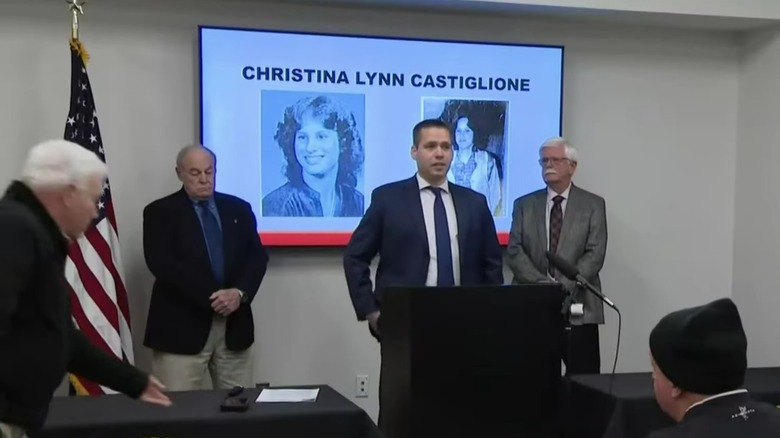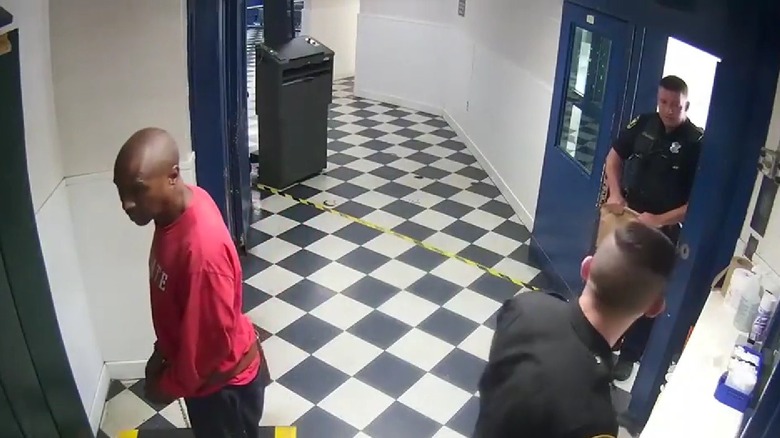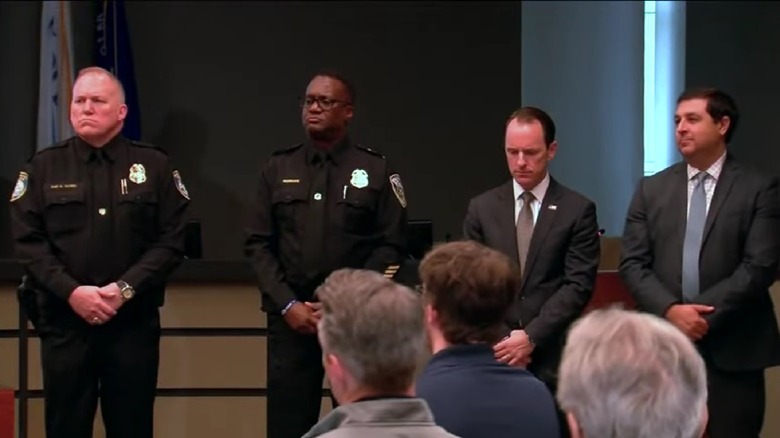41 Cold Cases That Were Solved In 2023
With the wealth of tools that modern homicide investigators have at their disposal, it has become mighty hard to get away with murder. Even disregarding the fact that the world is much more heavily monitored and densely connected than ever before, the practice of using DNA technology to identify parties involved with a crime has been continually refined, ever since it was first used in criminal cases in the early '90s.
These days, a suspected murderer need not even necessarily be identified by their own DNA — familial, or "genealogy" DNA, is just as effective a tool in some cases, and the use of DNA evidence combined with classic investigative techniques to solve cases is proving to have a wider reach on a year-by-year basis. This tech is so effective that its retroactive application is putting more and more murderers of years past, long before its use came into vogue, in the crosshairs of law enforcement. And even without DNA evidence, fresh case-breaking leads can materialize decades later; sometimes the criminals flash their cards, perhaps by bragging over drinks in a pub, or confiding to a friend.
Virtually every state, county, and province in North America has a backlog of active cold case investigations, but those backlogs are starting to get a little thinner, due to two factors: the inevitable march of technology, and the fact that homicide investigators never, ever give up. Here are some of the most stubborn cold cases those investigators were finally able to crack in 2023.
The following article includes allegations and descriptions of domestic abuse, sexual assault, child abuse, suicide, and violent death.
The family of Debbie Lynn Randall gets closure
In September 2023, authorities in Marietta, Georgia, were finally able to put to rest a mystery that had haunted the area for five decades. All the way back in January 1972, nine-year-old Debbie Lynn Randall remained behind at a laundromat after her stepfather went home for the evening. She then vanished without a trace, until two weeks later — when the worst was confirmed. Her body was found, having been dumped far from home, and with only a vague description of a possible suspect's truck to go on, leads in the case quickly dried up.
The Marietta Police Department, though, had done an exemplary job of obtaining and preserving evidence collected from the scene — and that evidence would be the key, over 50 years later, to identifying the murderer as then-24-year-old William Rose. Familial DNA was used to pinpoint Rose with cooperation from his family, who had been oblivious to his potential involvement in any crime; he died by suicide in 1974.
Randall's brother, pictured above, was one of her remaining family members to finally receive closure in the case, which was given an eloquent postscript by cold case investigator Morris Nix. "Technology does not get old, it doesn't retire, it doesn't get sick, and it doesn't quit," he said. "Technology was seeking William Rose and it found him in the grave" (via Atlanta News First).
Investigators never forgot Laura Kempton
In July 2023, the New Hampshire attorney general issued a report that doubtless brought a measure of peace to the family of Laura Kempton, a 23-year-old hairdressing student who was found murdered in her apartment in 1981. At the time of the crime, DNA evidence had been collected from the scene, but literally all it was able to determine then was that the perpetrator had been a man, which didn't give investigators much to go on.
Thanks to the tireless efforts of law enforcement and a diligent reevaluation of the evidence using modern genetic genealogy technology, though, that decades-old DNA profile finally yielded the identity of the killer: Ronney James Lee, an Army veteran who had served prison time in the late '80s for burglary and sexual assault.
Kempton's surviving family issued a statement praising investigators (pictured above), saying, "Their diligence and determination, along with extraordinary personal commitment over the past decades, have led to this moment for Laura" (via ABC News). Lee died of a drug overdose in 2005, but Kempton's family can finally rest easy in the knowledge that her killer doesn't walk free. Said Portsmouth Chief of Police Mark Newport, "The members of the Portsmouth Police Department have never forgotten about Laura and any of the other victims of our unsolved homicides."
A long road to justice for Sharron Prior
The 1975 abduction and murder of 16-year-old Sharron Prior, a resident of Quebec whose body was found in a wooded area in the town of Longueuil days after her disappearance, was an exceedingly tough nut for homicide investigators to crack. They had little more than a witness description of a suspect to go on, and over nearly five decades, they focused on a seemingly endless series of suspects, eventually investigating more than 100 individuals. Finally, in 2022, they happened upon a name that would prove to bear fruit: Franklin Romine, a man with a long history of criminal activity who was known to elude authorities by constantly moving between Canada and West Virginia.
When investigators uncovered a link between DNA collected in 1975 and a family who had long resided in West Virginia, they were able to establish cause to exhume the body of Romine, an ex-convict who had passed away in 1982. An examination of DNA collected from his body confirmed with one hundred percent certainty that he was indeed the individual responsible for Prior's murder — a conclusion which, at long last, yielded some closure for the victim's mother, Yvonne (pictured above), who had never given up on finding her daughter's killer.
Rita Curran had a deadly encounter with a neighbor
The murder of 24-year-old Rita Curran was every parent's worst nightmare; on her own for the first time and living with acquaintances in an apartment in Burlington, Vermont, Curran was sexually assaulted and strangled by an unknown assailant one night in 1971. Police were able to lift DNA evidence from the crime scene, the most viable of which came from a cigarette butt found next to Curran's body — but it never returned any matches from the national DNA database once it became active in 1998, nor did it match any of the roughly dozen suspects the cops had taken an interest in. Over time, the murder became the Burlington PD's oldest unsolved case — until a crack team of detectives, assigned to the case in 2022, took a fresh look at the evidence through the lens of modern technology.
Using newly extracted DNA and the wider scope of public ancestry records, investigators were able to pinpoint William DeRoos, a neighbor who lived two floors above Curran (pictured above, next to her surviving sister) in the same apartment building, as the perpetrator of the crime. DeRoos' then-wife Michelle, who now uses a different name, confirmed for investigators that they had had a fight on the night of the murder, and that her husband — who had confessed to her that he had a prior criminal history — had gone out for some time afterward. The couple soon divorced, and in an interview with police, DeRoos' second wife, Sarah Hepting, asserted that he had once strangled her — an eerie shadow of Curran's manner of death. DeRoos died in 1986.
Police pursued Carol Sue Klaber's killer for decades
It took multiple generations of Boone County, Kentucky homicide investigators to finally bring to a close the case of Carol Sue Klaber (pictured above in a news report), who was sexually assaulted and murdered all the way back in 1976. Speaking with The New York Times in March 2023, soon after the conclusion was announced, investigator Coy Cox revealed how former colleague Jerry Keith had obsessively compiled information on the case, keeping the file with him at his home: "He literally carried this case with him his whole life," Cox said. While the suspects Detective Keith had focused on did not pan out, Detective Cox nevertheless credits him with helping bring the case to its eventual closure, noting, "... a lot of times, you have to prove who didn't do it to get to who did."
That person was Thomas Dunaway, only 19 at the time of the murder, whom investigators zeroed in on after securing a match with familial DNA. Dunaway, in the years after killing Klaber, had enlisted in the Army, but was soon after arrested for possessing an illegal firearm; years later, he had killed someone else, eventually spending seven years in prison.
Dunaway died in 1990, making the finding a bittersweet one for Klaber's brother Thomas, who had undertaken the unenviable task of identifying his little sister's body. He told the Times that he was comforted, though, in the knowledge that there had been no need to exhume Klaber's remains to resolve the crime — the remains of Dunaway had instead been processed to secure an exact DNA match. "There's a little bit of justice," Klaber said. "You're going to disturb somebody's remains? Dig him up."
Justice just missed the killer of Vicki Johnson
In 1991, in the sleepy coastal town of Seaside, California, 34-year-old Vicki Johnson, a mother of three, met a horrendous end at the hands of a mysterious perpetrator. Johnson had been strangled and smothered, and her body had been set on fire in what may have been an attempt to destroy physical evidence. If that was indeed the case, the attempt was not successful; investigators were able to obtain DNA evidence from under her fingernails, the lone piece of evidence in a crime that offered no witnesses or other physical evidence of any kind. Long cold, the case was revived by a cold case task force in 2021 — and in cooperation with the Seaside PD, detectives were able to re-examine that evidence to find their man.
Unfortunately, the gears of justice turned just a bit too slowly in this case. The DNA led police to Frank McClure, an ex-convict who had not been a suspect in the investigation at any time, and who had no apparent ties to the victim. Forty-six years old at the time of the slaying, McClure carried the secret of what he had done for three full decades before passing away in 2021, at the age of 77, some two years before he was identified as the killer.
Cathy Sposito's killer was shockingly young
In 1987, 23-year-old Catherine "Cathy" Sposito was hiking a trail near Prescott, Arizona, on what should have been a normal day of sunshine and recreation. Instead, it unexpectedly morphed into the stuff of nightmares, and the last moments of Sposito's life. Out of nowhere, an attacker set upon Sposito, one whose onslaught was shockingly ferocious; the young woman was struck with a rock and a wrench, shot through one eye, and stabbed in the head, all in the space of mere moments. Nearby hikers heard her screaming for help — but in the seconds it took for them to reach her, she was dead, and her attacker was gone.
With no witnesses, the case went cold. But in 2017, investigators used DNA to link a different attack on the same trail to a surprising suspect: Bryan Bennett, who was a high school junior at the time of the killing, and had died by suicide in 1994. Bennett was connected to several other violent crimes, including sexual assault and kidnapping, and after exhuming his remains, investigators definitively concluded that DNA retrieved from the wrench used in Sposito's murder was a match for his.
Vickie Lynn Belk's killer will finally face justice
The 1979 murder of Vickie Lynn Belk, who left work at the Maryland Department of Agriculture one afternoon, only to somehow wind up dead of a gunshot wound by the side of a rural road the next day, puzzled investigators for decades despite diligent processing of the crime scene for evidence by authorities.
As the years went by, that evidence was continuously re-evaluated to see if updated technology could produce results — and in late 2022, they zeroed in on a possible suspect, 63-year-old Andre Taylor, who had been a teenager at the time of the slaying. Taylor's address records were out of date, however, and it took a concerted effort between agencies to locate him in 2023, living in Washington, D.C.
Taylor had been involved in multiple violent crimes in the intervening years, but the random nature of Belk's murder had kept him off the radar for that particular attack. Presented with the DNA evidence, a grand jury returned an indictment, and Taylor was finally arrested for Belk's murder and sexual assault in June 2023. In a statement, Belk's surviving family members, who include her mother (pictured above), said, "Nearly 44 years ago, our family lost Vickie Lynn Belk, a beloved mother, sister, and friend to a tragic and heinous crime ... We are grateful for the tireless efforts of the Charles County Sheriff's Office detectives and the forensics personnel who never ceased seeking justice on Vickie's behalf."
Detectives solve the mystery of the Lady of the Dunes
In 1974, Massachusetts newlywed Ruth Marie Terry departed for a trip to Tennessee with her new husband, Guy Muldavin. The pair were to visit Terry's family — but they didn't see her on that trip, and in fact, they never saw her again. When Muldavin returned to Massachusetts, he was driving Terry's car, and he informed family and friends that, wouldn't you know it, she had unexpectedly passed away.
Meanwhile, in Cape Cod, authorities were puzzled by the appearance of a young woman's body, mutilated beyond recognition, which had turned up among the sand dunes of the famous spot (pictured above). The "Lady of the Dunes," as she came to be known, had died of blunt force trauma to the head — but that was virtually all that was known about her, until she was finally identified as Terry in late 2022. The police then turned their attention to Muldavin, who — prior to marrying Terry — had been a suspect in the deaths of a former wife and a stepdaughter, and who had passed away in 2002. In light of a re-examination of all the available evidence, and with Terry finally having been identified after nearly five decades, authorities announced in August 2023 that they were confident that Muldavin was responsible for his wife's murder — bringing to a close the investigation into the oldest unidentified murder victim in Massachusetts's history.
The killer of Barbara Villareal is now behind bars
In 1986, Garland, Texas, resident Domingo Villareal gave police a horrific story after his 27-year-old wife, Barbara, was stabbed to death inside their home. He had, he said, heard his wife screaming in another room, and when he came to assist, he discovered armed intruders attacking her. They had then fled, but not before inflicting mortal wounds on Barbara. Police ran tests on blood that was found outside the home, and indeed, it was discovered to belong to neither Barbara nor her husband (both pictured above). Something, though, wasn't sitting right with detectives — and as it turned out, the victim's husband was lying about more than just the circumstances of his wife's death.
Decades after the crime, a review of the evidence by investigators turned up a startling fact: according to his fingerprints, Domingo Villareal was an alias. His real name was Jesus Canales, and DNA typing of the original blood sample led investigators to focus on his brother, Liborio Canales. While Jesus had passed away in Mexico in the '90s, Liborio was alive and well — and at the ripe old age of 85, in July 2023, he confessed to Barbara Villareal's murder when confronted with the evidence, saying that he had stabbed her over a family dispute of some kind.
Said the victim's brother, Marc Dunderman, "We're happy that there's closure ... It doesn't reverse any of the pain that she suffered at the end of her life and the void that we all have and have had for nearly 40 years" (via NBC Dallas-Fort Worth). Liborio Canales was arrested and charged with murder for Villareal's slaying.
The law catches up to the killers of Laurel Jean Mitchell
The 1975 death of Indiana teen Laurel Jean Mitchell, who had failed to turn up for a meeting with friends after leaving a church camp, shocked the community of North Webster; Mitchell was violently drowned (location pictured above), and an autopsy revealed she had struggled mightily for her life.
Mitchell's younger sister Sarah Knisely, only 12 at the time of her murder, would tell The New York Times decades later, "It was just a very small town, laid back. We felt safe ... We came and went as we pleased in the summer and parents didn't worry about us." Local police quickly became interested in two possible suspects: Fred Bandy Jr. and John Wayne Lehman, both of whom lived within a short distance of the crime scene, and one of whom drove a car similar to one that witnesses thought may have been involved in the crime. Unfortunately, there was simply not enough evidence at the time to arrest them, let alone convict them.
That all changed in the intervening years. On multiple occasions within the last decade or so, the pair suggested to friends and acquaintances that they may have been involved in the crime, and a new evaluation of DNA lifted from Mitchell's clothing finally provided investigators with what they needed in 2023. While those investigators declined to provide the exact techniques used, they were able to obtain arrest warrants for Bandy and Lehman, both 67 years old, and charge them with murder. Knisely succinctly summed up the duo's arrest: "It's been 47 years," she said, "But right now it feels like yesterday."
Pamela Lynn Conyers is still remembered
Pamela Lynn Conyers was only 16 years old when, while going to the mall to buy shoe polish for a school dance the next day, she happened upon the predator that would take her life. Conyers (pictured above) was strangled and asphyxiated, her body dumped near a highway that was under construction, and her death stunned close-knit Anne Arundel County, Maryland. But it was 1970, and the physical evidence collected from the crime scene was not enough to point police toward any suspects; the case went cold, and it remained that way for 52 long years.
It was the steady advances in DNA technology which finally allowed the case to be closed. Using a publicly available commercial database and investigative genealogy, authorities were finally able to pin the crime on Forrest Williams, only 21 at the time of the murder, who would not have set off any alarm bells back in 1970; he had no connection to Conyers, and even in the years since her death he amassed only a petty criminal record.
Williams passed away in 2018, and unfortunately, by the time the crime was solved, nobody was left to mourn Conyers. Michael Golden, a high school classmate, attended the announcement of the resolution of the case, where he offered a sad coda to the decades-long story. "I still mourn her death. I got to be old. She didn't. She's forever 16," he said. "It's something that all of our classmates, all of our peers have been struggling with for all these years" (via The Baltimore Banner).
Jennifer Odom's killer may be headed to death row
The 1993 abduction and murder of 12-year-old Jennifer Odom in Pasco County, Florida, was a case that investigators poured their time, resources, and hearts into for decades to no avail. The lively, active little girl had been abducted after getting off the school bus at her regular stop near home; her abductor had bludgeoned her to death and left her body in an orange grove miles away. Over the years, investigators piled up a mountain of evidence, erected billboards, offered rewards, and even successfully lobbied for the case to be featured on the TV show "Unsolved Mysteries" — but the case stubbornly remained unsolved.
However, in 2015, they caught a break. DNA evidence had led them to arrest a man for a very similar crime, in the same area, and around the same time — Jeffrey Crum (pictured above by police at a news conference), whom they had identified through investigative genealogy as the man who had abducted, beaten, and sexually assaulted a 17-year old high school student just over a year before Odom was killed.
The similarities between the two cases immediately made Crum the prime suspect in Odom's murder, and after using undisclosed methods to re-evaluate biological evidence left at the crime scene, Crum — already in prison for the earlier sexual assault — was formally charged with Odom's killing. Prosecutors announced that they would be seeking the death penalty.
The killer of Gretchen Harrington fesses up
The abduction and beating death of 8-year-old Gretchen Harrington in 1975, as she walked to her last day of Bible school, devastated the small community of Marple Township, Pennsylvania. It was a crime that took investigators nearly five long decades to solve, but in this case, the break came not from improved technology, but — amazingly — from a witness, who at the time was friends with the daughter of David Zandstra, a pastor at the Bible school (pictured above). Zandstra had, she said, attempted to grope her during a sleepover at his house — and she also recalled a former classmate having a couple of close calls with an adult who attempted to kidnap her, a man the witness suspected may have been Zandstra based on her experience with him.
Police had interviewed Zandstra at the time of the crime, but he had denied seeing Harrington at all that day, and despite the fact that multiple witnesses had placed him in the area where she was abducted, there was not enough evidence for an arrest. When presented with the new recollections of the witness, however, the now-83-year-old former pastor admitted that he had given Harrington a ride that day; he had asked that she take off her clothes, and when she did not, he had cruelly beaten her to death.
Upon the occasion of his arrest, District Attorney Jack Stollsteimer did not mince words, saying during a press conference, "He's gonna die in jail ... Then he's gonna have to find out what the God he professes to believe in holds for those who are this evil to our children" (via NPR).
Familial DNA nails the killer of Linda Fields
The murder of Linda Fields of Racine, Wisconsin, was a case that hit several frustrating dead ends before it was finally cracked. In February 2000, the 37-year-old woman was discovered strangled to death under a tree in a residential front yard, and several quality DNA samples were recovered from the scene. They were genetically identical and pointed to a single male perpetrator — but the state's DNA database returned no matches with them, and with no smoking gun, investigators had their work cut out for them. Over the years, lead investigator Steve Mich interviewed witnesses, gathered evidence, and eventually zeroed in on five possible suspects — none of whom were a match for the DNA profile in evidence.
In 2021, detectives took a new look at the two-decade-old case, this time employing investigative genealogy. After a potential match was made with a deceased individual, they began to focus on that person's still-living brother and father. The brother was eliminated, so the focus turned to the father — Lucas Alonso, a Zion, Illinois, resident whose DNA was subsequently obtained by police via a search warrant. That sample was found, with near-absolute certainty, to be a match for that collected from the long-ago crime scene — and finally, after 23 years, the cops had their man. Alonso was arrested at work and charged with the murder of Fields, an outcome that serves as a testament to the sheer dogged determination of the investigators on the case (pictured above).
Mary Davis' family can rest easy
One spring day in 1987, Mary Davis of Lexington, North Carolina — a married mother with two children — departed the Ace Hardware store where she worked (pictured above), and simply didn't return. Her husband Richard grew concerned that she hadn't come home from work after he returned from his sister's house, and the very next day, the worst was confirmed: Davis was found behind an area supermarket, strangled to death. DNA samples collected from the scene proved to be of no help to investigators at the time — but Davis' case remained open, and with the help of investigative genealogy, it can now be closed.
The DNA evidence was re-examined using the latest techniques in 2022, and it generated leads for investigators that eventually led to the identification of Lexington resident Russell Wood, who passed away in 2013. After reviewing the conclusions drawn by detectives, District Attorney Garry Frank provided her family with a letter stating that, had he been living, Wood would have been charged with crimes including first-degree murder and sexual assault.
Speaking with local CBS affiliate WFMY News, Davis' daughter Traci — just an infant at the time of her death — expressed relief at the resolution of the case, and offered a plaintive memorial for her mother. "They tell me I look a lot like her, and I act like her sometimes," she said. "I've always heard that she was kind and sweet, and that she had a lot of patience, and she just liked people."
Police close the case of Christina Castiglione
Redford Township, Michigan resident Christina Castiglione was only 19 years old when she met her end at the hands of a man who would go unidentified for 40 years. In March 1983, Castiglione left a group of friends to walk home after arguing with a boyfriend. She then vanished, and remained missing for eight long days before her body was discovered miles away; she had been sexually assaulted and strangled.
DNA recovered from the scene was carefully preserved, and was entered into a database two decades later, but it returned no matches at that time. Thanks in part to a grant from a nonprofit called Season of Justice, though, the latest technology was applied to the samples in early 2022 — and this time, they would help investigators close the case.
A genealogy profile built from the samples led police to living relatives of Charles Shaw, an area man with a troubled past and criminal history who had passed away in 1983. Those relatives readily cooperated with the investigation, and with their help, detectives (pictured above) — including Edwin Moore, who had worked the original case in 1983 — were able to definitively identify Shaw as the perpetrator of the crime. The cold case was the first to be solved by the Livingston County Sheriff's Office with the assistance of DNA genealogy technology, but it almost certainly won't be the last; according to the County's website, the cold case team is currently putting that grant to good use by employing the technique to tackle four additional unsolved homicides (via Detroit News).
Donna Sue Hyatt's killer is finally identified
The 1987 sexual assault and murder of Carlsbad, New Mexico, resident Donna Sue Hyatt is a case which, if not for the diligent processing of the crime scene by the investigators who initially responded, might never have been solved. While the DNA collected from the scene sat in a warehouse awaiting the march of technology, police followed up on leads: Hyatt had last been seen at a store in Carlsbad with a tall, Caucasian, male companion, but interviews with the witnesses who offered up this information unfortunately yielded little else that was useful. The investigation soon hit a wall — but in 2023, it came roaring back to life.
DNA testing with the latest technology had led cold case detectives to focus on Michael Wigley, whom they confirmed was living in Carlsbad at the time of the crime, and who had served prison time for sexual assault. Wigley died in a car accident in 1989 and was buried in Amarillo, Texas; working with authorities there, Carlsbad police exhumed his body, which yielded DNA confirming that he was Hyatt's murderer.
During a press conference, Carlsbad mayor Dale Janway thanked the investigators on the case for their diligence, and remarked, "We would also like to recognize the officers and detectives from 1987 who responded to the residence that tragic night. Their diligent work and dedication to the crime scene integrity and collection of potential evidence proved to be the difference in making it possible for officers to bring resolution to this case."
The killer of Todd Lampley was tripped up by his taste in TV shows
The 2011 shooting death of Cape Cod, Massachusetts, resident Todd Lampley remained a mystery for 12 years, until a pair of seemingly innocuous clues led detectives to their man. Lampley had been shot inside the bedroom of his home, and police had recovered a phone from the crime scene; unfortunately, the phone yielded no physical or forensic evidence, and it was registered in the name of Marlo Stanfield, a name which would only be known to fans of the classic HBO TV series "The Wire" as one of the show's characters. It apparently took detectives some time to put this together — but once they did, the fact that a mutilated potato (of all things) was also found at the scene took on new significance.
Investigators had never recovered any DNA from the scene, but in an episode of "The Wire," a potato was used as a silencer — and once it dawned on investigators that it had likely been put to the same use in their cold case, the potato found at the scene was examined more closely. It yielded DNA that matched Devarus Hampton (pictured above), who had previously accused Lampley of being involved in the shooting death of an acquaintance in 2007, a crime for which Lampley was never charged. An examination of records from an ankle monitor Hampton had been wearing at the time of Lampley's murder placed him at the crime scene, giving prosecutors a pretty iron-clad case after 12 years.
A long-ago DNA sample nails the killer of Patricia Carnahan
In 1979, police in El Dorado County, California, were baffled by the case of an unidentified woman who had been beaten and strangled to death at a Lake Tahoe campground. It took over a quarter century for the victim to be named; investigators on the case made public a piece of jewelry she had been wearing at the time of her death, which finally prompted her daughter to come forward to identify her in 2015 as Patricia Carnahan. The identity of her killer, though, remained a mystery until 2023 — when a Washington State audit of its backlog of sexual assault collection kits bore unexpected fruit.
The kit in question was from 1994, and contained the DNA of Harold Carpenter, who had been accused of, but not charged, with sexual assault in Washington that year. As part of the backlog-clearing initiative, the DNA from that long-ago kit was uploaded to CODIS, the FBI's DNA database — where it was matched with DNA taken from the 1979 crime scene. Carpenter was arrested in March in Spokane, and it was reported at the time that he was to be extradited to California to stand trial for the murder. In a statement, Washington Attorney General Bob Ferguson made a public appeal for more states to follow Washington's lead, saying, "Cases like this illustrate the need to test every sexual assault kit and get their DNA profiles loaded into the federal database. Every untested kit could be a potential break in a cold case."
If you or anyone you know may be the victim of child abuse, domestic abuse, sexual assault, and/or is in crisis, contact the relevant resources below:
-
The Childhelp National Child Abuse Hotline at 1-800-4-A-Child (1-800-422-4453) or contact their live chat services.
-
The National Domestic Violence Hotline at 1−800−799−7233. You can also find more information, resources, and support at their website.
-
The Rape, Abuse & Incest National Network website or contact RAINN's National Helpline at 1-800-656-HOPE (4673).
-
Call or text 988 or chat 988lifeline.org
Carol Reiff's neighbor couldn't escape the law
When 59-year-old New Jersey woman Carol Reiff failed to show up for a family trip in 2013, family members might have been a bit concerned — but the last thing any of them suspected was that she might have been the victim of a violent crime. Speaking with CBS News Philadelphia, her daughter Dawn Centanni said, "She was just so kind and gentle. It just seems like such a weird fate for her." But sadly, after going missing for four days, Reiff's body was discovered in a patch of woods near a highway miles from her home. In the decade that followed, investigators would keep the case at the front of their minds, confident that it would eventually be solved — and in May 2023, not two weeks after announcing that the case was making headway, an arrest was finally made.
While the initial analysis of DNA recovered from the crime scene had yielded inconclusive results, advances in the technology allowed police to zero in on 59-year-old Joseph Grisoff, who had lived near Reiff's apartment and had been interviewed early in the investigation. Grisoff claimed during that interview that he had never been inside Rieff's apartment, but the new analysis of the crime scene DNA put the lie to that claim, and gave detectives enough to charge him with murder. "The Gloucester Township Police Department and the Camden County Prosecutor's Office have never forgotten about Carol Reiff," police chief David Harkins said in a statement. "I am very proud of the collaboration and teamwork of the detectives who have worked countless hours which led to this arrest today."
The mystery of Larry Fuller's death is finally solved
The 2009 murder of Durango, Colorado, man Larry Fuller rocked that small mountain town, being the type of crime its residents just aren't used to seeing. While on his way home from a New Year's Eve celebration at a local bar, Fuller was shot dead on the street right in front of the community church — and, as the 49-year-old stepfather was not exactly the type to look for trouble and the crime appeared to be a random one, police had a difficult time pinpointing any suspects. Fuller's companion, Paula Silva, told police at the time that he had not gotten into any altercations of any kind at the bar that night, and the initial round of witness interviews produced no good leads.
In February 2023, the Colorado Bureau of Investigation took over the case, conducting new interviews with those present at the bar that night — and this time, they hit paydirt. Based on those interviews, they identified and obtained a confession from 38-year-old David Hendren, who told police that he had mistaken Fuller for somebody else. Monyca Escalante, Fuller's stepdaughter, told the Durango Herald that as surreal and random as Fuller's murder had been, she was amazed that police were finally able to bring his murderer to justice. "I never thought, ever, that they were going to figure it out," she said. "It's like a dream come true."
Patricia Joseph gets justice at long last
In 2005, the tiny Northern California town of Fort Jones was devastated by a brutal crime: 56-year-old Patricia "Patty" Joseph, a well-known fixture in their community, was discovered bound, beaten, and asphyxiated to death in the Klamath River, several days after going missing. The crime stuck in the craw of local authorities, and in 2010, they thought they had their man: Philip Frayes, a Mendocino County marijuana farm operator for whom Joseph is thought to have once worked as a trimmer. Unfortunately, the veracity of the physical evidence gathered from the crime scene was not enough for a conviction, and kidnapping and murder charges against Frayes were ultimately dropped.
That did not mean, however, that he was off the radar of law enforcement. After a new cold case team, employing modern technology, was established by the Siskiyou County Sheriff's Office in 2021, Joseph's cold case quickly went back under the microscope, with Frayes as the focus. After a thorough review of the evidence, the cold case team determined that it was indeed compelling enough to once again charge Frayes, now 75 years old, for Joseph's murder. Sheriff Jeremiah LaRue, who spearheaded the formation of the cold case team, said in a statement, "This arrest is the result of the determination of our investigators and reflects our faithful commitment to pursuing justice for victims of violent crimes and their families. Our cold case team will continue to focus on these cases with dedication."
Cynthia Ruth Wood's killer finally stops running
The murder of Bradenton, Florida, woman Cynthia "Cindy" Ruth Wood in 1984 was not exactly a mystery; before her death, she had met with a man named Donald Santini, who had promised to provide her with damning information on her husband Barry, with whom she was involved in a custody battle. The mystery lay in what had become of Santini after the crime — as he had simply vanished, leaving behind exactly zero clues as to his whereabouts. Despite being profiled on "America's Most Wanted" three separate times in the space of 23 years, and the determination of investigators to bring him to justice, Santini remained a ghost — until 2023, when a single tip from a Fugitive Task Force brought his four-decade-long flight to an end.
Santini was finally collared living in the tiny town of Campo, California, where folks knew him as Wellman Simmonds, a 65-year-old married family man and the president of the local water board. According to prosecutors, Santini had killed Wood while fleeing Texas authorities after a convenience store robbery, and he had continued to elude investigators by using over a dozen different aliases over the years. During his arraignment, Judge Catherine Catlin ordered Santini held without bond while awaiting trial, at the request of Wood's family. "You are the definition of [a] flight risk," she told Santini. "There is nothing I can do to preserve the safety of this community if I was to [give you bond]."
The killer of Joyce Casper finally has a face
The 1987 murder of Joyce Casper, who had been found beaten to death behind the Boise, Idaho, greeting card store she owned, was one that required a great deal of patience and determination for investigators to finally close out. Weeks before her murder, Casper had reported being assaulted in her store by a young man with slicked-back hair, which was about the only viable lead police had to go on; following it, though, had produced nothing. DNA taken from the crime scene was doggedly and diligently run through the national DNA database again and again, for decades, in hopes of a match which it never produced.
Finally, in 2019, a new detective assigned to the case decided to take a look at the DNA evidence through the lens of genealogy, which enabled him to narrow down the suspect base to a single family. Members of that family provided swabs to investigators, which allowed them at long last to identify their murderer: Frank Rodriguez, a local man who passed away in 2007. In a press release, police captain Matt Jones acknowledged the bittersweet nature of the case's resolution. "While nothing can bring back their lost loved one, we are proud that after 36 years and countless hours of investigation, we were able to bring some form of closure to the Casper family," he said. "We are proud and grateful to finally be able to give them some answers."
Police never gave up on nailing the murderer of Nusinaida Ramos
For investigators, the road to justice for 34-year-old Nusinaida Ramos, who was strangled to death in her Yonkers, New York, apartment in 1997, was a frustratingly long one. As agonizing as it must be when the identity of a murderer stubbornly refuses to reveal itself, one can imagine that it must be even more difficult for the cops when they know they have their man, but there simply isn't enough evidence to make an arrest — and so it was in the death of Ramos, whom police always suspected was murdered by her estranged husband and father of her two small children, Rafael Ramos.
Ramos, a former Sing Sing correctional officer, told investigators that he had found the door locked with music blaring from inside the apartment when he arrived to drop off the children one night, and his wife had failed to answer the door; finding the situation to be the same the next morning, relatives allowed police to enter, and they found Nusinaida Ramos deceased amidst signs of a violent struggle. While investigators reported that they had a strong suspect in the early '00s, they privately told family members at that time that they were leery of making an arrest absent a confession. That, apparently, is no longer the case. While whatever new evidence has been uncovered has not been made public, police finally arrested Rafael Ramos in June 2023 — giving Nusinaida's mother, who told the Journal News that she had resigned herself to "going to the grave with nothing ever happening in this case," a measure of closure.
David Malcom died to protect a stranger
David Malcom was only 26 when, while working at a Red Cross shelter in Ithaca, New York, in 1987, he was killed by parties unknown. Investigators at the time were eyeing a co-worker of Malcom's as a possible suspect, but that avenue didn't pan out; DNA evidence was collected from the scene, but it yielded no information with the technology available. The case sat unsolved for 36 long years, until advances in DNA tech revealed the truth: that Malcom had died a hero. Pressed by the ex-boyfriend of a teenage shelter resident to reveal the girl's location, Malcom had refused to do so, and for that, he had lost his life at the man's hands.
The identity of Malcom's killer was not made public, but police did disclose that he passed away in 2019. The resolution of the case was announced by an Ithaca Police Department press release that noted Malcom's bravery and dedication to those under his care. "Mr. Malcom's heroic actions for not disclosing the whereabouts of the young teen sadly cost him his life," it read; it also stated that police chief Vincent Monticello had spoken with the family of the victim to offer an apology for taking so long to bring their son justice, though it's tough to see what they could have done differently. "Many of the tools, training, and resources used today to solve homicides were not available," to detectives all those years ago, it noted — but, as with all cold cases, investigators never stopped seeking justice for Malcom.
The mysterious case Krisann Baxter is finally closed
The death of 16-year-old Krisann Baxter, who was strangled and dumped in a pine grove near Spokane's Whitworth University in 1978, was another that was simply waiting patiently for the science of DNA genealogy to catch up to the available evidence. While ample DNA was collected from the scene at the time of the crime, there was little that could be done with it — and after a month of failing to turn up any solid leads, police were well and truly stumped. At that time, Sheriff's Lieutenant Robert Sennette spoke to the press, saying, "Do cases get any tougher than this one?" He then answered his own question: "Not a hell of a lot" (via The Spokesman-Review).
Following further testing in 2006, the presence of male DNA was found in the samples collected from the scene, but efforts to find a match with any potential suspects in the national DNA database bore no fruit. Finally, in 2023, a renewed investigative focus employing genealogy allowed police to name the killer: Keith Lindblom, who had copped a plea to narrowly avoid being convicted for sexually assaulting a different 16-year-old girl in 1975, and who had died in a house fire in 1981. Unfortunately, the development came a hair too late for Baxter's brother, Steve Baxter, who had carried out the unfortunate task of identifying his sister's body; he passed away in early 2023, just months before Lindblom was identified as the murderer.
Jeremy Stoner wasn't the only victim in his heinous murder
The 1987 death of 6-year-old Jeremy Stoner, who was kidnapped, sexually abused, and murdered in Vallejo, California in 1987, was an unthinkable tragedy compounded by another one — the lifelong cloud of suspicion that hung over Shawn Melton, long the only suspect in the case, for a crime he did not commit. Based on a tip from Melton's therapist and detailed information Melton had given to police, investigators were convinced that the troubled man had committed the crime; he spent a total of 19 months in jail for it and was tried twice, with both trials ending in hung juries. Melton died in 2000 with police certain that they had allowed the killer to slip through their grasp — and so they had.
In 2023, a re-examination of the DNA evidence from 1987 excluded Melton as the perpetrator of the crime, and pointed cops in the direction of the actual killer: 69-year-old Fred Cain, now living in Oregon, who police suspect may have been involved in a similar crime a month prior to Stoner's death. Cain was arrested and charged with multiple crimes, and while Stoner's family was not ready to go on record with any comment, Cain's niece, Cris Delaney, was. Speaking with CBS News Sacramento, she alleged for the first time that Cain sexually abused her for years, saying, "For me to think about what this poor little boy went through, and on top of it Shawn lived his life treated the way he was ... It makes me so angry."
The disappearance of Crystal Rogers continues to generate mystery
The 2015 disappearance of 35-year-old mother of five Crystal Rogers of Bardstown, Kentucky, proved to be a difficult case for investigators to untangle. Early on in the investigation, her boyfriend Brooks Houck was named as a person of interest, and he remained so for eight years — in an investigation that, for all that time, failed to yield a body or remains of any kind. Bizarrely, not even a year and a half after Crystal's disappearance, her father Tommy Ballard was preparing for a hunting trip, when he was shot once in the chest from a distance by an unknown gunman, killing him — and, perhaps not-so-surprisingly, it turns out that the two cases are intertwined.
After the investigation was taken over by the FBI in 2020, previously searched locations — including Houck's family farm and other properties owned by his relatives — were inspected again with fresh eyes, and while whatever new evidence was obtained was not made public, it was enough to indict 32-year old Joseph Lawson with conspiracy and evidence tampering — an indictment that was followed just weeks later by the arrest of Houck for murder. The following month, at a court hearing prosecutors told the judge that they were closely eyeing a gun owned by Houck's father, Nick — a weapon they believe was used to murder Ballard. The court proceedings are still ongoing as of this writing.
The killer of Cathy Swartz finally gets collared
Nineteen-year-old Cathy Swartz of Three Rivers, Michigan, was the victim of a brutal attack in December 1988, one that took her life — but she did not go without a fight. Investigators at the time determined that, perhaps due to the presence of her 9-month-old daughter Courtney in the next room, Swartz fought back courageously against her unknown attacker, but was ultimately overwhelmed by her injuries — which included beating, stabbing, and strangulation. Police amassed mountains of evidence, including DNA, footprints, and even fingerprints, and interviewed hundreds of potential witnesses — but the case would not be cracked, even after the DNA evidence was submitted to the national database over a decade after the fact.
Once again, it was DNA genealogy and modern investigative techniques that finally cracked the case. With an assist from Western Michigan University students, who helped detectives to organize thousands of documents related to the case, police narrowed their focus to four brothers: One of them was determined to be a more likely candidate than the others based on his history, and the story told by the aforementioned mountains of evidence. After interviewing him and collecting DNA and fingerprint samples, police finally arrested 53-year-old Robert Waters of South Carolina, who would have been a mere teenager at the time of the crime. Speaking with CBS News Channel 3 Kalamazoo, Detective Chuck Christensen shared that even for Waters himself, the arrest had an air of inevitability. "I think he had an idea at some point police would arrive and want to talk to him," Christensen said. "It's hard to say what would be going through your mind after 35 years."
Helen and Maynard Fine were murdered by their own son
On May 20, 1977, a telephone line repair worker in Maryville, Tennessee made a shocking discovery: the body of a woman, 54-year-old Helen Fine, sitting in a car outside of her home. Mrs. Fine had suffered multiple gunshot wounds, and when police were called to the scene, they found that her husband, 67-year-old Maynard Fine, had met the same fate — he had been shot to death inside the home. The murder weapon was subsequently located in a local landfill, and although physical evidence was collected from the crime scene, investigators were unable to definitively tie anyone to the crime for almost five decades.
The breakthrough finally came when that diligently collected evidence was re-examined using modern technology, and said evidence pointed in a horrifying direction. District Attorney Ryan Desmond and Police Chief Tony Crisp (pictured above) announced in November 2023 that said evidence had placed the Fines' son Michael — 34 at the time of the crime — to both the entryway of the house and the murder weapon. At 80 years old, Michael Fine was finally arrested for the murder of his parents — and while authorities are obviously confident enough in their case to make that arrest, they are as of this writing seeking one more piece of the puzzle: a teenage girl, whose name they do not know, who was living with the Fines at the time of their murder. "They would not be a suspect at all in this, but they ... observed some things in the weeks or months leading up to the homicide that potentially could be very relevant," Desmond explained (via WATE 6).
Baby Jane Doe got her name back: Kenyatta Odom
Since 1988, a terrible discovery made at a dump site in Millwood, Georgia, has haunted residents of that state: the body of a young girl, identity unknown, which had been stuffed into a duffel bag, encased in concrete, and hidden inside an old television cabinet. The girl known as "Baby Jane Doe" went unidentified until June 2023, when investigators were able to use familial DNA to determine her identity: 5-year-old Kenyatta Odom, whose case had received renewed attention a few months earlier when authorities issued a public plea for help in cracking the case.
This plea had reached a former neighbor of Kenyatta's mother, Evelyn Odom, who had explained Kenyatta's disappearance by saying she had gone to live with her father, a story that the neighbor felt was a little suspect. This neighbor tipped off the police, and when Kenyatta was identified, they zeroed in on Odom and her then-live-in boyfriend Ulyster Sanders. In November 2023, the cops arrested the pair, charging them with the girl's murder along with supplemental charges including first-degree cruelty to children and conspiring to conceal the death of a person. At a press conference, Georgia Bureau of Investigation Special Agent Jason Seacrist publicly broke the news of "Baby Jane Doe's" identification. "Finally, after almost 35 years, not only were we able to identify her remains of who Baby Jane Doe was, but we were also able to make the arrest of those that we believe were responsible," he said (via ABC 11). Odom and Sanders are awaiting trial as of this writing.
Clifford Smith's murder finally led to an arrest
In late 2023, Jackson County, Indiana saw the resolution of one of its oldest cold cases: the murder of 24-year-old Clifford Smith, whose body had been discovered in the woods outside Seymour, Indiana about a month after he had been reported missing by his wife in 1982. Smith had been shot in the head with a shotgun and left to die, and over the years, the case had its way through generations of detectives — before Sergeant Kip Main took over in 2015.
In the course of his investigation, Main was able to determine that Smith had last been seen in the company of Ronald Anderson, an acquaintance with whom he and several others had been hanging out into the wee hours of the night on October 30, 1982. Anderson and Smith had left together, with Anderson returning briefly to retrieve (wait for it) a shotgun. That was the last time Smith had been seen alive. The following morning, Anderson had returned to the house in order to, as investigators put it, "hide potential evidence" (via NBC News). In light of these findings, the 61-year-old Anderson was arrested at his home in Seymour and charged with Smith's murder in November 2023.
Estella Mena's murdered had already died
Sunnyvale, California police were for decades stumped by the brutal murder of Estelle Mena, who was stabbed to death outside the business where she worked as a security guard all the way back in 1979. But it was at a previous job, at the amusement park Great America, that she met the man that police now know to have murdered her — Samuel Silva, whom police nearly overlooked when they developed a lead on a different suspect in 2022. DNA evidence collected from the crime scene failed to confirm that individual's involvement, though, and police soon zeroed in on Silva, who had lived in the area and had a history of violent crime including sexual assault.
Investigators were able to put together a viable DNA profile on Silva, and this time it was a match. Although he died in prison while serving a sentence on federal gun charges in 2008, authorities were at least able to close a case that had been a thorn in their side for over 40 years. "We don't forget the victims, and we don't forget the families and friends of those victims who still want justice," District Attorney Robert Baker told the press (via 6 News WOWT). "No matter how many years it's been ... we want to get justice for those people."
The family of Ricky Ridings is thankful for the truth
In 1981, police in Callaway County, Missouri discovered the body of 27-year-old Ricky Ridings in a truck; he had been shot to death, and the cops may not have been terribly surprised. At the time, Ridings was known to be involved in a lucrative crime ring, trafficking in drugs and stolen cars, which was active in the St. Louis area — but with no witnesses and no viable evidence, they were unable to pin the crime on anybody. That may have remained the case forever, if not for what may have been a flash of conscience on the part of Ridings' killer — Charles Schmitt III, who since 1998 had been serving a life sentence with no chance for parole in a different murder case.
In 2017, police received information that Schmitt had admitted to killing Ridings in a recorded phone call from prison. Authorities began pursuing capital murder charges against him, but in 2023, a charge of manslaughter was ultimately decided upon after Schmitt agreed to sit down with Ridings' family to face questions about the crime that only he would know the answers to. That occurred in August, and Schmitt was subsequently sentenced to an additional 10 years, the maximum sentence. In a press release (via the Fulton Sun), prosecuting attorney Chris Wilson said, "At the end of the sentencing, the Ridings family thanked Mr. Schmitt for his candor regarding his role in Ricky's murder, demonstrating a remarkable, and extremely unique, instance of restorative justice."
Solving the murder of Karen and Gordon Alexander was personal
In April 1981 in Texarkana, Arkansas, police were called to a horrifying crime scene by Weldon Alexander, a married father of two. Inside his house, his young boy Gordon lay dead; in a bedroom, his teenage daughter Karen was found on a bed, grievously injured but still alive. Alexander told the cops that he had arrived home from an overnight shift at a tire factory to find his front door open, and that it must have been intruders who had done the terrible crime. Karen was taken to a hospital, but died of her injuries — and while they weren't able to pin the crime on anyone using available evidence, they were convinced the case was closed when infamous serial killer Henry Lee Lucas confessed to killing the Alexander children while in jail.
Like many of Lucas' "confessions," though, this turned out to be false. Thanks to the dogged determination of now-retired police captain Calvin Seward (who basically made it his personal mission to resolve the case) and improved DNA technology, investigators were finally able to pin the crime on Weldon Alexander, who died in 2014; he had slain the children while his wife was in the hospital after attempting to sexually assault Karen. "I kept a picture of the kids right above my desk and I would look at them and I would go right to the photos and look at those kids," Seward told the press in announcing the case's closing (via KSLA News 12). "It would break your heart. I got kids the same age; my daughter was a classmate of Karen."
Krista Martin's case was solved by genetic genealogy
The case of 20-year-old Krista Martin, who was discovered dead in a home in Wichita, Kansas in 1989, stands as a sterling example of how sheer diligence can lead to the resolution of a murder case that for years had stubbornly refused to yield any suspects. DNA evidence was carefully collected from the scene, which bore no fruit; this evidence was reviewed by the FBI in the early '90s, to no avail. The evidence was not sent back to attempt to find a match in the national database until 2009, by which time the murderer — a man named Paul Hart — had been, unbeknownst to investigators, dead for ten years.
Even though Hart could no longer commit any crimes that might result in his DNA being added to the database, investigators kept doggedly reviewing the evidence, and in 2021 and 2022, they worked with private genealogists to attempt to put together a profile of the suspect. Turning to familial DNA finally produced results, and Hart was identified as the only viable suspect in April 2023; Hart lived in the same neighborhood as Martin, although police were unable to determine whether they actually knew each other; Martin was known to befriend people she met while out at local watering holes, though, and it is theorized that she simply put her trust in the wrong man. Detective Adam VanDerMolen summed up the investigation succinctly while talking with the press (via CNN), saying, "This was a long road."
Pearl Davis and Christina King's murderer probably killed others
In September 2023, improved DNA technology helped police to crack an exceedingly brutal pair of crimes: the murders of Pearl Barnes, also known as Sameemah Musawwir, discovered stabbed to death in a vacant lot in Kansas City, Kansas, in 1996; and the 1998 beating death of Christina King, a young mother whose body was found behind an abandoned building in the same city. The culprit: a man who was questioned in one of the cases two decades ago. Gary Dion Davis Sr., now 52 years old, was a long-haul trucker based in the city whose DNA profile was matched to evidence found at both crime scenes; given the apparently random nature of the crimes, authorities believe they are likely not his only two victims.
"We believe that once we're done with the investigation that we may be able to connect him to other cases, but we still need the public's help," Police Chief Karl Oakman said in a press conference (via The Kansas City Star). "In my experience, based on him killing two women, most likely he's killed more." Davis is, as of this writing, in jail awaiting trial on two murder charges, and the cops are confident they'll be able to slap him with more. Oakman had an ominous message for anyone else thinking they had gotten away with a crime in his city: "It may not be today. It may not be tomorrow. In fact, it may not be this year. But there's gonna be a time," he said. "You may be in a drive-thru line. You may be at the grocery store. We're gonna eventually get you."
A cigarette led to an arrest in Herman Brown's murder
Prosecutors in Cincinnati, Ohio finally got their man in the heinous 2003 murder of Herman Brown, whom authorities found after a wellness check on him was requested by a neighbor who called 911 to report a stench coming from his apartment. Responding officers came upon a horrendous scene; Brown was dead on the floor inside, having been strangled with an extension cord and stabbed multiple times, with blood found in multiple rooms. Some of that blood did not belong to Brown, and other forms of DNA evidence including cigarette butts were found — but the cops were unable to use it to finger a suspect until 2023.
Investigators re-examined DNA lifted from one of the cigarette butts through the lens of forensic genealogy, and at long last, it pinpointed Brown's killer as now-64-year-old Robert Stewart after an exhaustive investigation. As Detective Jeff Smallwood explained to WCPO Cincinnati, the process they used to nail Stewart involves combing through hundreds of names returned from public genealogy databases using traditional police work, which enables the cops to snare criminals whose DNA has never been collected by law enforcement. "It is a puzzle," said one of the detectives assigned to the case, Heather Saidler. "And it can be really hard at times." But that hard work paid off; as of this writing, Stewart is in jail awaiting trial on a charge of first-degree murder.
Diane Olkwitz and Terri Erdmann were killed by the same man
In October 2023, police obtained a search warrant to exhume the body of Clarence Tappendorf, who passed away in 2008. Way back in 1966, Tappendorf had been a delivery truck driver, and in late October of that year, he had made a delivery across the street from Kenworth Manufacturing in Menomonee Falls, Wisconsin, which would be the scene of a brutal crime just four days later. The 19-year-old Diane Olkwitz, who worked at the warehouse, was found dead in the machine shop area; she had been stabbed over 100 times.
Police were also looking at Tappendorf for a very similar crime that occurred in Milwaukee, just a couple miles away, five years later. Terri Erdmann was found behind a department store in June 1971; she had likewise been stabbed in the neighborhood of 60 times, and the similarities between the crimes did not escape the cops at the time. The twin cases had been handed down from lead detective to lead detective at both cities' police departments over the years, and a number of suspects had been considered and dismissed before DNA genealogy pointed them to relatives of Tappendorf, who voluntarily gave them the DNA samples they needed to confirm that he was the killer. In announcing the resolution of the cases, Attorney General Josh Kaul praised the two departments for their cooperation over a very long haul. "I hope this sends a message," he said (via CBS 58), "that law enforcement will not give up on solving these cases, whether it is days, months, or even decades."




